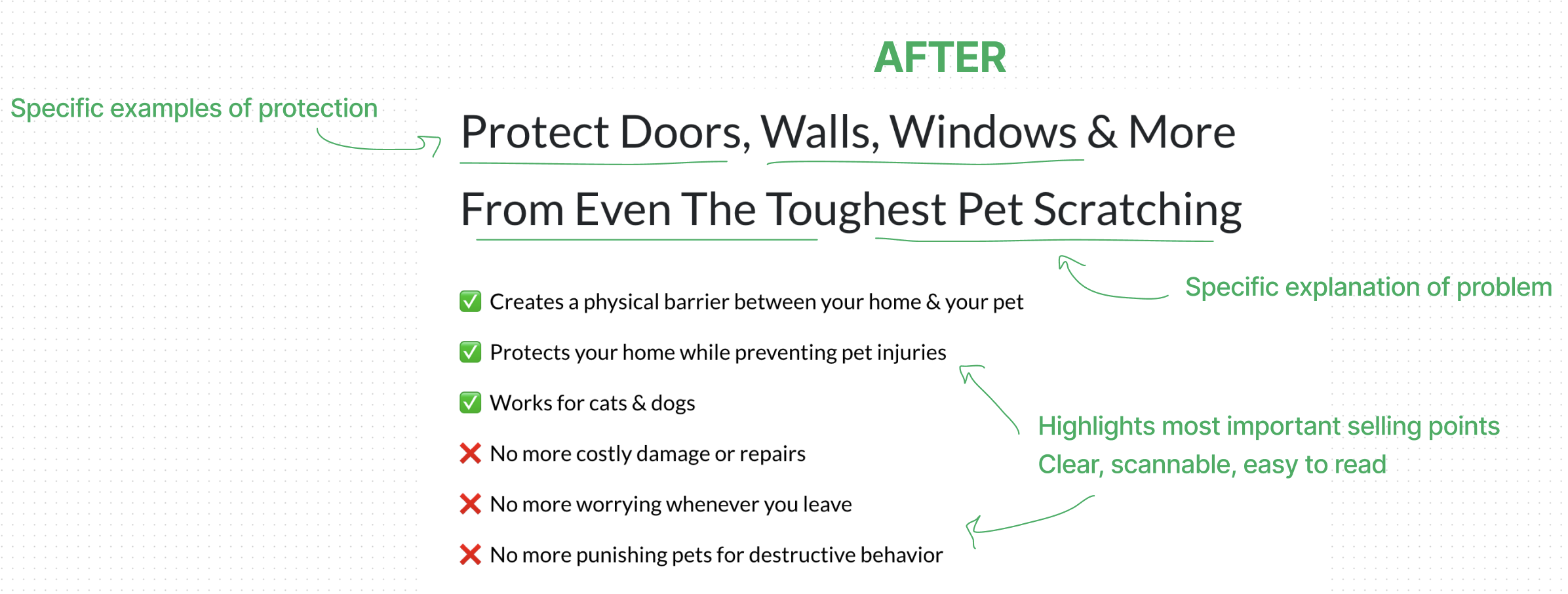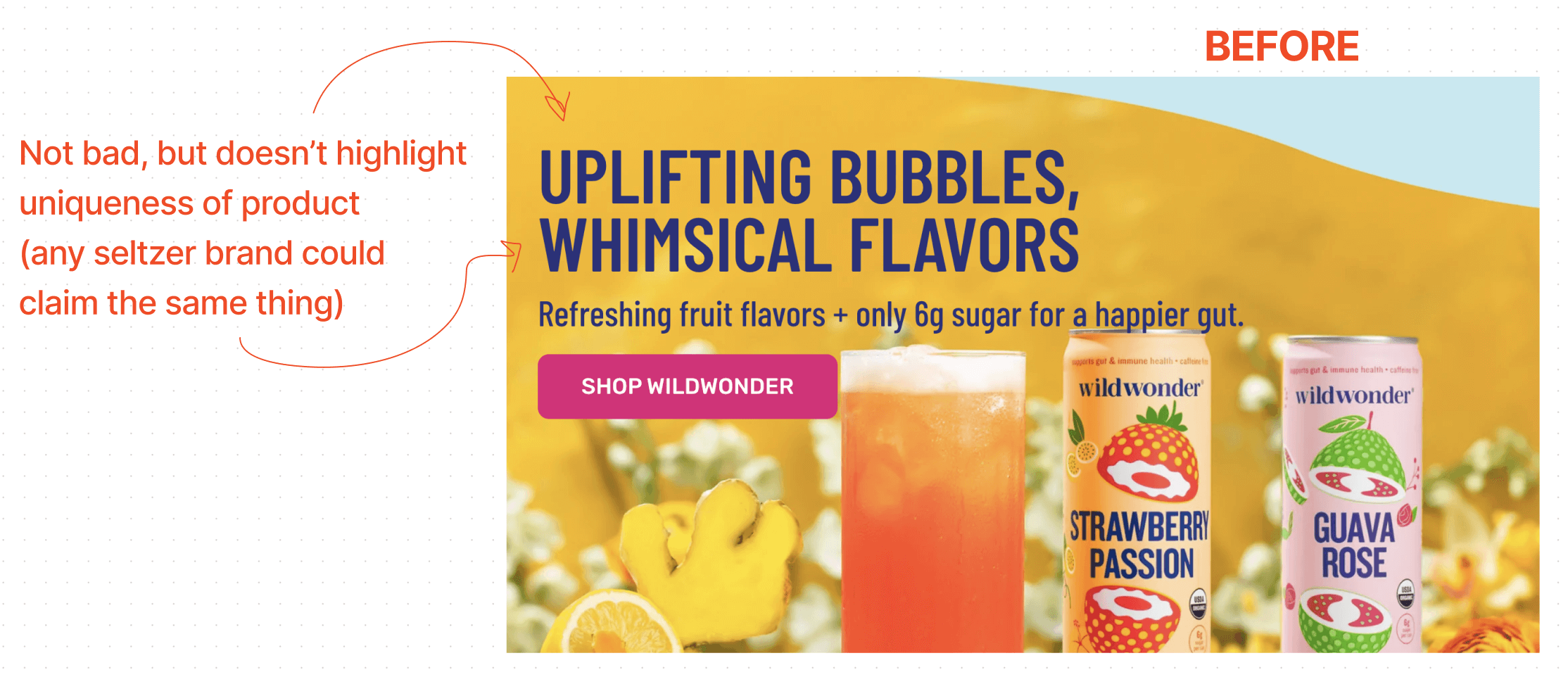As we all know, writing headlines is crucial to engaging visitors and motivating them to take a desirable action.
But writing clear and persuasive headlines isn’t always easy (though I do have a simple, 3-step process for writing effective headlines if you’d like to check it out).
In fact, some of the best products in the world have some of the WORST copy I’ve ever seen — which means writing good headlines doesn’t necessarily come down to resources or budget.
It’s more about having the right skills and knowledge to do it correctly.
Part of that is knowing what NOT to do when it comes to writing effective headlines, including:
❌ Using vague language that doesn’t communicate information or sell
This is the #1 problem I see with headlines.
The copy is too general and vague and doesn’t get specific as to what the product is, what it does, who it’s for, how it works, the benefits it offers, etc.
Instead, the copy is so general and vague it basically does NOTHING and could be slapped across a similar product and absolutely no one would know the difference.
❌ Forgetting to focus on what makes their product unique or special
It’s honestly shocking to see how few brands articulate and/or highlight what makes their product unique, special, or different.
Usually that CRUCIAL information is completely omitted from headlines (including hero headlines) and instead, is often buried somewhere in a long, clunky paragraph no one will ever read or see.
Differentiating your product (whether in headlines or elsewhere) is one of the MOST IMPORTANT things you can do with your copy, so it really pays to focus on it.
❌ Trying to be “cute” or “clever” (vs clear & specific)
Businesses get so focused on “personality” and “tone” that they forget the main purpose of the words – to communicate information and persuade people to take action.
If you can balance both, more power to you.
But in my experience, most brands struggle with this, which is why I often see copy that feels cringey, nonsensical, or just “off” in some way.
And usually the “personality” they’re trying to infuse into the copy isn’t even that unique, interesting, or detectable, which makes the “sacrifice” even worse.
❌ Sacrificing sales for SEO
I’ll be the first to say that SEO is incredibly important for a lot of brands, but it shouldn’t be the only priority when it comes to crafting effective headlines or copy.
There must be a balance between clarity and capturing traffic. But here’s what happens:
A brand hires an SEO person or agency who – for their own reasons – prioritize SEO above all else. This often causes the copy to become diluted, difficult to read (too many keywords, long/clunky paragraphs) and ultimately less effective.
You may have made these same mistakes when it comes to crafting effective headlines, but it’s not too late to learn how to do it right.
Today, I’m sharing a few before and after headline examples to show you how to take “bad” (or just “basic”) headlines that aren’t doing much educating or selling and amp them up to become clearer, more specific, and more persuasive.
Keep in mind, these are just examples. There are a million different ways each example could be written, so if you have more ideas for how you’d improve them, feel free to comment below.
Psst! Have you heard about my FREE headline writing workshop? If you’re interested in joining, click here
Alright, let’s get into it starting with everyone’s favorite marker…Sharpie!
Headline Example 1: Sharpie
Why the original copy doesn’t work:
- “More to love” doesn’t mean anything
- “More to love” doesn’t speak to any goals, pain points, results, etc – it communicates nothing
- Repeating “Sharpie highlighters” in headline may be good for SEO, but doesn’t help with selling or persuading visitors to click (would be better to use on a product page if SEO is the goal)
- Description of colors in subheadline is good, but could be enhanced
- Image of product “in use” is disconnected from copy

Why the updated copy works:
- Speaks directly to the goals and outcomes it helps you achieve
- Uses formatting (in this case, capitalization) to grab attention and stand out
- Use of the word (“POP!”) adds emphasis, energy & emotion
- More descriptive language of colors makes them sound more vivid & exciting
- Copy in headline and subheadline now reinforces the image of the product in use

Headline Example 2: Pure Enrichment
Why the original copy doesn’t work:
- Headline isn’t specific; it doesn’t tell me what the product is or why it’s special
- Subheadline doesn’t tell me what it can do for me or why I should care
- Because the copy is so vague, the image does not make much sense

Why the updated copy works:
- Headline tells me exactly what the heating pad offers (heat, massage, weighted comfort)
- Subheadline tells me specifically how the heat, massage, and weighted comfort will help me and clarifies the 3-in-1 aspect
- With clearer copy in the headline/subheadline, the visual now makes much more sense

Headline Example 3: Clawguard
Why the original copy doesn’t work:
- Headline is good, but a little vague; it could use more specific language
- Subheadline is way too long; it might be useful for SEO, but it’s not good from a UX standpoint (too clunky, not scannable or easy to read)

Why the updated copy works:
- Headline is highly specific
- Headline lists specific examples of what the product protects
- Headline calls out the problem using very specific language
- While the design needs work, the subheadline is now clear & easy to scan/digest
- Most important selling points are clearly seen and less likely to be missed in a long, clunky paragraph
- Still room for a short subheadline and/or more bullets (depending on SEO needs)

Headline Example 4: Wildwonder
Why the original copy doesn’t work:
- Headline doesn’t highlight uniqueness of product
- Subheadline could do a better job of calling out the key selling points (gut health, taste, low sugar)
- Headline isn’t “ownable” to the brand, meaning any seltzer brand could claim the same thing

Why the updated copy works:
- Headline highlights uniqueness of product (healthy & delicious)
- Headline piques interest and curiosity (why is it good for me?)
- Subheadline calls out the 3 most important selling points in a clear & scannable way (I know, it’s hard to read with the busy design in the background, but hopefully you get the idea)

Headline Example 5: Swedish Dishcloths
Why the original copy doesn’t work:
- Headline may be good for SEO, but it’s not doing any selling, educating, persuading, etc
- Neither headline nor subheadline tell me why the product is unique
- Copy is not “ownable” to the brand, meaning similar products could make the same claims

Why the updated copy works:
- Headline highlights specific aspect of product (sustainability, etc) which also showcases uniqueness
- Uses specific copy (1 cloth = 17 rolls paper towel) to grab attention while highlighting a unique aspect of the product (and an important selling point this type of customer would care about)
- Offers a clear solution to the customer’s problem (keeping a clean home without producing tons of waste)
- Subheadline showcases key selling points that are unique to the product (reusable, biodegradable, compostable) ← could also potentially be helpful for SEO

Have a headline YOU want to improve?
Check out my Headline Writing Workshop which teaches you how to write headlines that engage customers, clearly explain your offer, and why someone should buy it now.
The 1-hour video training focuses on 6 rules for writing effective headlines and includes plenty of real-life examples (+18 practical tips) that will help you improve your own copy.
As always, thank you for reading. I hope you found the before and after headline examples helpful (if so, feel free to share this article with a friend, boss, or colleague).
Happy headlining!
